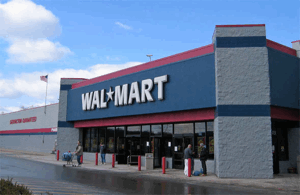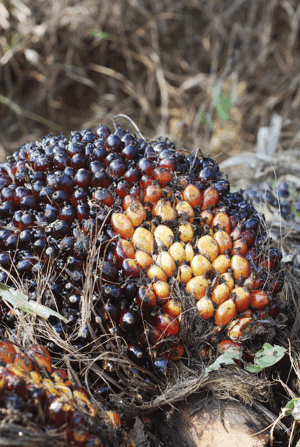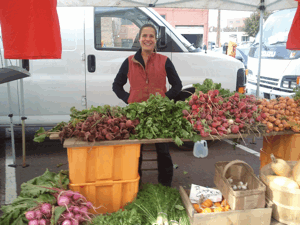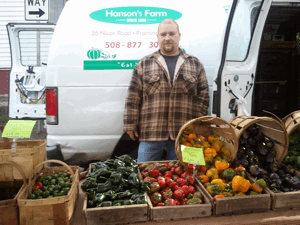Giant Walmart Thinks Small
Air Date: Week of October 22, 2010

The superstore Walmart is considering buying food from local farms. (Wikipedia Creative Commons)
Walmart recently announced plans to get more of its food from local sources and small to mid-sized farms. To learn what's in it for the big box retailer, host Bruce Gellerman talks to Michelle Harvey who leads Environmental Defense Fund's partnership with Walmart. LOE also reaped opinions from growers at a Massachusetts farmers’ market who are skeptical of the plan.
Transcript
GELLERMAN: It’s Living on Earth, I’m Bruce Gellerman. Walmart is the largest retailer in the world. Last year, its U.S. revenues alone were a quarter of a trillion dollars …and half of that came from selling food.
Now, the big box seller is starting to think small. Walmart has announced a new strategic sustainability initiative to help small and medium size farms not just survive but thrive. Environmental groups including World Wildlife Fund, Conservation International and Rainforest Alliance are working with Walmart to design the company’s program and monitor its progress. Michelle Harvey is a project manager at Environmental Defense Fund. EDF is one of the groups also working with Walmart. Ms. Harvey, welcome to LOE.
HARVEY: Thank you, glad to be here.
GELLERMAN: So, let’s talk about this deal. Big deal, big company- what are they trying to do?
HARVEY: What they’re going to do is expand to a greater number of locally grown farms. They’re looking for opportunity to increase the number of farmers, the types of food that the farmers are growing and to really increase the diversity of sources that they have for the food that they sell in their stores around the world.
GELLERMAN: So what is the specific goal in terms of the amount that they are going to be sourcing from small farmers?

Michelle Harvey worked with Walmart to develop their sustainable agricultural platform. (Photo: Michelle Harvey)
HARVEY: In the U.S., they’re looking to increase that number to about nine percent. It essentially is to double the amount of produce that they are purchasing locally. In the United States, for instance, it’s within a state’s boundaries.
GELLERMAN: And, it’s not just the United States, this is a global initiative.
HARVEY: Walmart spent about 18 months really working with organizations like Environmental Defense Fund, but also with their sustainability teams in the countries where Walmart is located around the globe. And, this effort really was looked at in a global perspective, so it will be happening in Brazil and Argentina, Japan and China, as well as in the US.
GELLERMAN: Different goals, different countries?
HARVEY: Same large goals, different implementation. For example, in Brazil, which is one of the key areas where cattle raising has resulted in a lot of deforestation, there’s a very targeted goal to only source beef in areas that can be certified as not causing harm to the tropical forests down there.

By 2015, Walmart will require that all of the oil palm for its store brand products be grown sustainably. (Wal-Mart)
GELLERMAN: How many farmers do you think they will be able to pull into this program?
HARVEY: The goal over the next five years is to engage somewhere in the ballpark of a million or more farmers.
GELLERMAN: So, Ms. Harvey, what’s in this for Walmart? What do they get out of it- why bother with so many local farms and farmers?
HARVEY: Walmart stands to get several things out of it. First and foremost, they get fresher food, which usually sells better with their customers. They have more diverse supply, which means if there’s a freeze in one part of the country they’ve still got a good opportunity to purchase a product without having to see the prices increase. It’s also about traceability. You know where your food is coming from if there’s a problem, as we’ve seen happen with e-coli over the last few years. It- much more quickly able to identify the source and address it. So, it’s better food, and it’s reduced risk.
GELLERMAN: Walmart is so enormous, this project will make them even larger, give them an even larger share of the market. Could that drive down the prices that they pay their farmers even further?
HARVEY: The goal of the project is to make harvest of food more efficient. But Walmart has expressed a strong commitment to leaving more of the profit with the farmer, which means the people today who might help to get the food from the farm to the store, are more likely the area where Walmart is going to look to become more efficient.

The superstore Walmart is considering buying food from local farms. (Wikipedia Creative Commons)
GELLERMAN: What’s good for the consumer, in terms of low prices and Walmart, in terms of market share, might not necessarily be good for farmers.
HARVEY: That’s the part that will be the most interesting in all of this. In the framing of the goal, the big question that was discussed was how do you help the farmer to get the prices he needs to support his family or her family- a lot of the farmers that Walmart will be looking to work with are actually women- but how do you keep the farm family well funded so that they stay in farming, and still maintain a good price. I think a good chance of what will happen is that more direct relationships will develop between farms and local stores. That’s going to help to give more money to the farmer but without so many middlemen, you may still actually see lower prices without it actually hurting the farms themselves.
GELLERMAN: Well, kind of win-win-win.
HARVEY: Well, there’s going to be folks in that supply chain who are going to fall out, a little bit. But I think for the planet, looking at the environmental impacts and then being able to help educate the farmer on how to farm in a better way, keeping farm families economically healthy, and then providing fresh food to the community, could- it has the potential to do a really, a really positive thing for how we produce our food.
GELLERMAN: Of course this is a promise. This is a project with a promise. Who is going to hold their feet to the fire?
HARVEY: One of the roles the NGO partners like EDF play are to really make sure that its implemented well, that the goals are really accomplishing what they say they’re accomplishing, and if they’re not, to help figure out why not and what we can do, suggest that Walmart do differently. Our expectation is that we will probably get about three years into this initiative, learn what’s working and what isn’t, and the goals will probably shift as they move forward. But, we’re optimistic that it’s all going to be pointed in the right direction to benefit the communities and to benefit the planet.
GELLERMAN: Michelle Harvey is project manager with Environmental Defense Fund, helping Walmart with its new ‘Global Ag Sustainability’ Program.
[SOUNDS OF SHOPPING MARKET]

Davis Square farmer’s market in Somerville, MA. (Photo: Honah Liles)
GELLERMAN: But, what about the smallest of the small farmers? Growers like these –farmers who do a brisk business selling rainbow chard, organic kale, and heirloom tomatoes at the weekly farmers market near our studios? I went shopping for opinions to find out if they think they’ll benefit from the Walmart initiative.
GELLERMAN: Uh, can I have two pounds of your honey-crisp apples please?
WADLEY?: Yes, you may. Do you want me to pick them out or do you want to pick them out yourself?
GELLERMAN: Uh, I’ll get ‘em, thanks.
WADLEY?: Yeah, here’s a bag, it will be about six apples… I’m Dan Wadley (sp?), and I’m a grower for Kimball Fruit Farm in Pepperell, Massachusetts.
GELLERMAN: Walmart is proposing that they greatly expand the amount of local produce and products that they buy from small farmers like yourself. Do you think that’s a good idea, would that be good for you guys?
WADLEY?: We grow and sell just what we can at our famer’s market and at our farm stand. So, for us it really won’t affect who we are or what we do. We’re just the right size for what we do.
[SOUNDS OF SCALE]

Farmer at the market. (Photo: Bruce Gellerman)
KIMBALL: My name is Ellery Kimball. I run Blue Heron Organic Farm in Lincoln, Mass. Small farms just don’t make much quantity. And it must be hard for small farms to supply a store or a chain of stores as big as Walmart.
GELLERMAN: Philosophically, would it be a good idea? I mean, here you are one of the smallest farmers in the country and they are one of the biggest retailers in the world.
KIMBALL: I think it’s better for consumers to go directly to the farms and to develop a relationship with the farmers- that way they know exactly what is going into their food and what is being used. So, when people come to my farm they know that we are not using pesticides or herbicides or fungicides. They know exactly what my farming practices are, and they get to interact with the place and get a better connection with their food. I think if they go to Walmart, they’re losing that farm-to-table connection, and I think that’s a sad thing.
HANSON: My name is Matt Hanson, from Hanson’s Farm in Framingham. We have a small, about 80-acre farm.

Farmer at the market. (Photo: Bruce Gellerman)
GELERMAN: So what do you think of the Walmart deal?
HANSON: It depends. It depends on how they treat us, because they could really destroy us with wholesale prices. For example, the wholesale price of corn this year was 13 cents and ear, and you can’t really make a living off of 13 cents an ear, no matter how much you sell. So, if they can keep up with regular grocery store prices for wholesaling, that’s fine. But if they can’t then I don’t think it’s a good idea.
GELLERMAN: They’re big.
HANSON: They’re huge! They can totally destroy a small farm, a whole bunch of small farms. Excuse me for one second….thank you very much …
[SCALE SOUNDS]
GELLERMAN: Thoughts about Walmart’s new Ag Initiative from small growers at the Davis Square farmers’ market in Somerville, Massachusetts.
Links
Living on Earth wants to hear from you!
Living on Earth
62 Calef Highway, Suite 212
Lee, NH 03861
Telephone: 617-287-4121
E-mail: comments@loe.org
Newsletter [Click here]
Donate to Living on Earth!
Living on Earth is an independent media program and relies entirely on contributions from listeners and institutions supporting public service. Please donate now to preserve an independent environmental voice.
NewsletterLiving on Earth offers a weekly delivery of the show's rundown to your mailbox. Sign up for our newsletter today!
 Sailors For The Sea: Be the change you want to sea.
Sailors For The Sea: Be the change you want to sea.
 The Grantham Foundation for the Protection of the Environment: Committed to protecting and improving the health of the global environment.
The Grantham Foundation for the Protection of the Environment: Committed to protecting and improving the health of the global environment.
 Contribute to Living on Earth and receive, as our gift to you, an archival print of one of Mark Seth Lender's extraordinary wildlife photographs. Follow the link to see Mark's current collection of photographs.
Contribute to Living on Earth and receive, as our gift to you, an archival print of one of Mark Seth Lender's extraordinary wildlife photographs. Follow the link to see Mark's current collection of photographs.
 Buy a signed copy of Mark Seth Lender's book Smeagull the Seagull & support Living on Earth
Buy a signed copy of Mark Seth Lender's book Smeagull the Seagull & support Living on Earth

